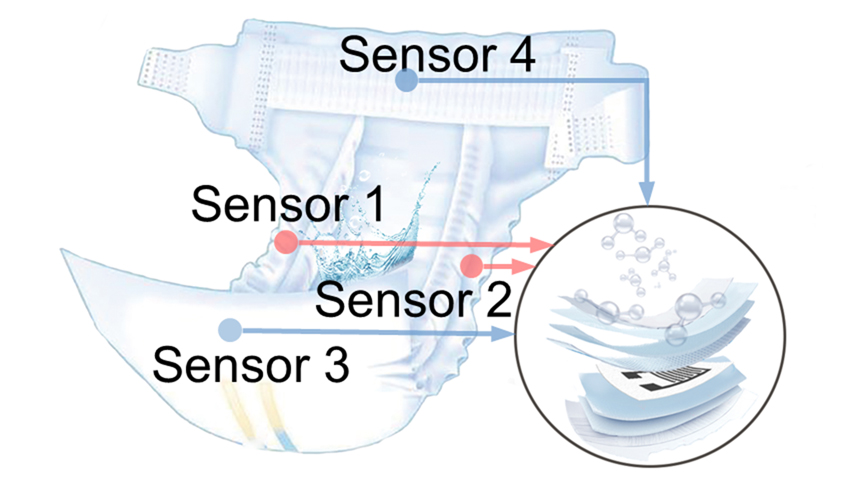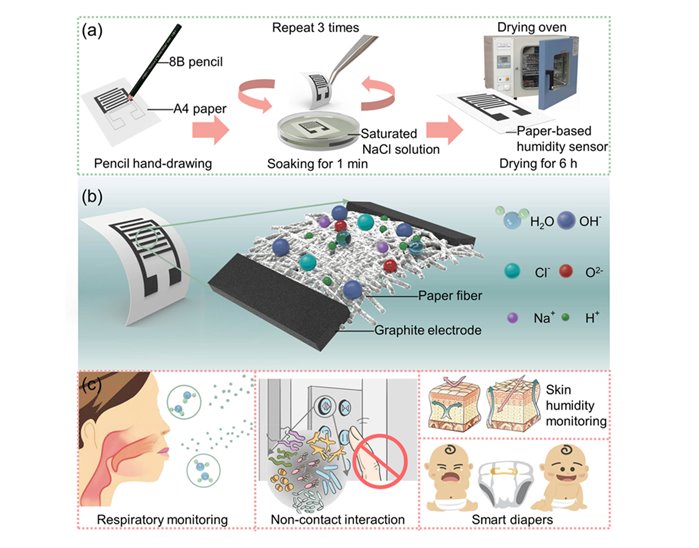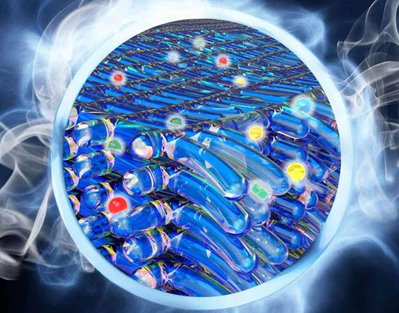Hydration Sensors Key to Smart Diapers
Hydration Sensors Key to Smart Diapers


A Penn State-led research team integrated four humidity sensors between the absorbent layers of a diaper to create a “smart diaper,” capable of detecting wetness and alerting for a change.
Imagine a sensor so indiscrete babies don’t know they’re wearing them. A “smart diaper” with sensors would immediately detect and alert caregivers about soiled shorts.
Researchers at Pennsylvania State University proposed the concept for a smart diaper in conjunction with their research to create a lightweight, flexible, and inexpensive hydration sensor. The diapers could be used in hospitals, daycares, or nursing homes to alert caregivers to a wet diaper, said Huanyu Cheng, professor of engineering science and mechanics at Penn State.
The sensors could have many other uses, such as inside masks to monitor respiration or worn on the skin to check for dehydration.
In fact, hydration sensors—activated by humid environments—play an essential role in monitoring human health. But it’s still hard to make them cheaply, in large quantities, and as sensitive as they need to be, Cheng said.
Other Sensor Applications: Sensor System Aims to Head Off Avalanches
Mass-produced, lightweight, and inexpensive sensors can be disposed of easily—as in the diaper example—and can be of particular use in developing countries, where cost is a consideration, said Christopher Foster who was a research associate on the project in 2016.
The Penn State team has created their humidity sensor using a pencil-drawn electrode (PDE) method, which involves the transfer of conductive carbon materials onto paper using a pencil. For this, the creators use a pencil to trace on the outline of a circuit board that has been lightly transcribed on paper treated with salt water.
Later, when the paper absorbs moisture, the salt and graphite interact to become ionized and set off the sensor. The key is working over a wide range of relative humidity from 5.6 percent to 90 percent, Cheng said.
“These are so light and easy to make they can easily be mass produced,” Cheng said.
For wireless applications, such as smart diapers and mask-based respiration monitoring, the drawing is connected to a tiny lithium battery that powers data transmission to a smartphone via Bluetooth. For other applications, such as for an environmental humidity detector, the paper is connected to a computer with copper wires and conductive silver paste, said Li Yang, who was also involved in the research. He is a professor in the school of artificial intelligence at Hebei University of Technology in China.
Become a Member: How to Join ASME
“We wanted to develop something low-cost that people would understand how to make and use, and you can’t get more accessible than pencil and paper,” Yang said in a statement.
The key to the smart diaper is that the sensors can be aligned in special arrays, in this case two near the “urination point” on the front, one on the side of the diaper and one on the back. Located within the absorbent layers of the diaper.
The sensors in the front of the diaper detect wetness after about 15 seconds and sensors on the back and side after around 30 seconds. Next, the sensor sends a message to a phone, alerting a caregiver that a diaper needs to be changed.
Because it detects humidity levels, it also notes how wet the diaper is, which helps caregivers decide if the diaper needs to be changed immediately, Yang said.
More Smart Devices: Smart Necklace Helps Users Stop Smoking
For the respiration monitor, the team drew the electrode directly on a solution-treated face mask. The sensor could tell the difference between mouth breathing and nose breathing and was able to tell deep, regular, or rapid breathing. Respiratory rate is an early indicator of conditions such as heart attack and pneumonia, Cheng said.
In the not-too-distance Internet of Things-connected future, a device within the mask could alert caregivers or paramedics to changes in a patient’s condition, he said.
So, whether to assess the state of one’s health, or one’s urinary output, lightweight, humidity sensors will make their way into many aspects of everyday life in the near future.
Jean Thilmany is a science and technology writer in Saint Paul, Minn.
Researchers at Pennsylvania State University proposed the concept for a smart diaper in conjunction with their research to create a lightweight, flexible, and inexpensive hydration sensor. The diapers could be used in hospitals, daycares, or nursing homes to alert caregivers to a wet diaper, said Huanyu Cheng, professor of engineering science and mechanics at Penn State.
The sensors could have many other uses, such as inside masks to monitor respiration or worn on the skin to check for dehydration.
In fact, hydration sensors—activated by humid environments—play an essential role in monitoring human health. But it’s still hard to make them cheaply, in large quantities, and as sensitive as they need to be, Cheng said.
Other Sensor Applications: Sensor System Aims to Head Off Avalanches
Mass-produced, lightweight, and inexpensive sensors can be disposed of easily—as in the diaper example—and can be of particular use in developing countries, where cost is a consideration, said Christopher Foster who was a research associate on the project in 2016.
The Penn State team has created their humidity sensor using a pencil-drawn electrode (PDE) method, which involves the transfer of conductive carbon materials onto paper using a pencil. For this, the creators use a pencil to trace on the outline of a circuit board that has been lightly transcribed on paper treated with salt water.
Later, when the paper absorbs moisture, the salt and graphite interact to become ionized and set off the sensor. The key is working over a wide range of relative humidity from 5.6 percent to 90 percent, Cheng said.
“These are so light and easy to make they can easily be mass produced,” Cheng said.
For wireless applications, such as smart diapers and mask-based respiration monitoring, the drawing is connected to a tiny lithium battery that powers data transmission to a smartphone via Bluetooth. For other applications, such as for an environmental humidity detector, the paper is connected to a computer with copper wires and conductive silver paste, said Li Yang, who was also involved in the research. He is a professor in the school of artificial intelligence at Hebei University of Technology in China.
Become a Member: How to Join ASME
“We wanted to develop something low-cost that people would understand how to make and use, and you can’t get more accessible than pencil and paper,” Yang said in a statement.
The key to the smart diaper is that the sensors can be aligned in special arrays, in this case two near the “urination point” on the front, one on the side of the diaper and one on the back. Located within the absorbent layers of the diaper.
The sensors in the front of the diaper detect wetness after about 15 seconds and sensors on the back and side after around 30 seconds. Next, the sensor sends a message to a phone, alerting a caregiver that a diaper needs to be changed.
Because it detects humidity levels, it also notes how wet the diaper is, which helps caregivers decide if the diaper needs to be changed immediately, Yang said.
More Smart Devices: Smart Necklace Helps Users Stop Smoking
For the respiration monitor, the team drew the electrode directly on a solution-treated face mask. The sensor could tell the difference between mouth breathing and nose breathing and was able to tell deep, regular, or rapid breathing. Respiratory rate is an early indicator of conditions such as heart attack and pneumonia, Cheng said.
In the not-too-distance Internet of Things-connected future, a device within the mask could alert caregivers or paramedics to changes in a patient’s condition, he said.
So, whether to assess the state of one’s health, or one’s urinary output, lightweight, humidity sensors will make their way into many aspects of everyday life in the near future.
Jean Thilmany is a science and technology writer in Saint Paul, Minn.







